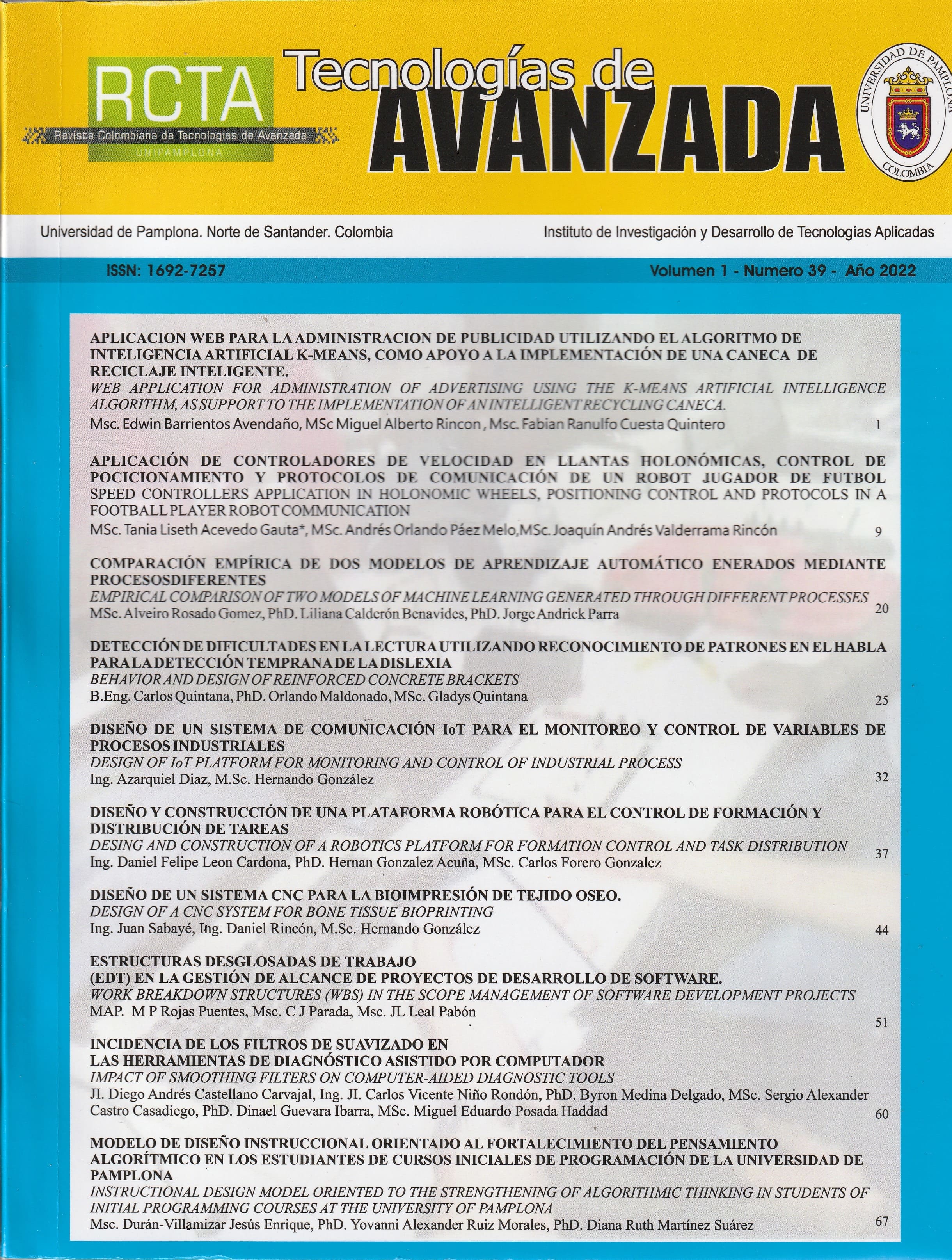Comparación empírica de dos modelos de aprendizaje automático generados mediante procesos diferentes
DOI:
https://doi.org/10.24054/rcta.v1i39.1369Palabras clave:
Aprendizaje automático, aprendizaje automático automatizado, estudio empírico, inteligencia artificialResumen
El aprendizaje automático, viene demostrando un potencial en la construcción de modelos que representan el comportamiento que existe en los datos, estos modelos son utilizados en diferentes áreas del conocimiento para optimizar las decisiones que se toman, el aprendizaje automático automatizado, es un campo de trabajo creado para satisfacer la demanda de herramientas que permitan la construcción de modelos de forma precisa, ágil y rápida y que estén disponibles para personas que no dominan la estadística y la tecnología. Esta investigación hace la comparación empírica del comportamiento de dos modelos generados utilizando herramientas de aprendizaje automático normales y automatizas para clasificar las personas desmovilizadas que pueden abandonar el proceso de reintegración. Existe coincidencia en el algoritmo que se utilizó, también en varios de los atributos que se emplearon y la evaluación sugiere que, para el conjunto de datos utilizado, el aprendizaje automático automatizado, tiene mejor rendimiento que el tradicional
Descargas
Citas
Aburomman, A., & Bin Ibne Reaz, M. (2016). Ensemble of binary SVM classifiers based on PCA and LDA feature extraction for intrusion detection. IEEE Advanced Information Management, Communicates, Electronic and Automation Control Conference (IMCEC) (págs. 636-640). Xian: IEEE.
Borana, J. (2016). Applications of Artificial Intelligence & Associated Technologies. International Conference on Emerging Technologies in Engineering, Biomedical, Management and Science (págs. 64-67). Jodhpur: SD-Technocrates.
Cath, C. (2018). Governing artificial intelligence: Ethical, legal and technical opportunities and challenges. Philosophical Transactions of the Royal Society A Mathematical, Physical and Engineering Sciences, 1-8.
Djukanovic, M., Berger, C., Raidl, G., & Blum, C. (2020). An A search algorithm for the constrained longest common subsequence problem. Information Processing Letters, 1-12.
Fu, Y., Yan, S., & Huang, T. (2008). Correlation Metric for Generalized Feature Extraction. IEEE Transactions on Pattern Analysis and Machine Intelligence, 2229 - 2235.
Han, J., Kamber, M., & Pei, J. (2012). Data Mining Concepts and Techniques (Tercera ed.). Waltham: Morgan Kaufmann.
He, X., Zhao, K., & Chu, X. (2020). AutoML: A survey of the state-of-the-art. Knowledge-Based Systems, 1-36.
Hernández Royett, J., Hernández, Y. F., Gil, M. de los A., & Cárdenas Barboza, E. (2018). Evaluación del modelo integrado de planeación y gestión (MIPG) en las entidades territoriales del estado colombiano. Aglala, 9(1), 444-463. http://revistas.curnvirtual.edu.co/index.php/aglala/article/view/1255
Jiménez-Carvelo, A., González-Casado, A., Bagur-González, G., & Cuadros-Rodríguez, L. (2019). Alternative data mining/machine learning methods for the analytical evaluation of food quality and authenticity – A review. Food Research International, 25–39.
Lakshmanan, V., Robinson, S., & Munn, M. (2020). Machine Learning Design Patterns. Sebastopol: O'Reilly Media.
Murdoch, W., Singh, C., Kumbier, K., Abbasi-Asl, R., & Yu, B. (2019). Interpretable machine learning: definitions, methods, and applications. Proceedings of the National Academy of Sciences, 22071–22080.
Nguyen, G., Dlugolinsky, S., Bobák, M., Tran, V., López, Á., Heredia, I., . . . Hluchý, L. (2019). Machine Learning and Deep Learning frameworks and libraries for large-scale data mining: a survey. Artificial Intelligence Review, 77–124.
Suresh, H., & Guttag, J. (2019). A Framework for Understanding Unintended Consequences of Machine Learning. arxiv, 1-10.
Telikani, A., Tahmassebi, A., Banzhaf, W., & Gandomi, A. (2021). Evolutionary Machine Learning: A Survey. ACM Computing Surveys, 1-35.
Varshney, K., & Alemzadeh, H. (2017). On the Safety of Machine Learning: Cyber-Physical Systems, Decision Sciences, and Data Products. Big Data, 246-255.
Waringa, J., Lindvallc, C., & Umetona, R. (2020). Automated machine learning: Review of the state-of-the-art and opportunities for healthcare. Artificial Intelligence In Medicine, 1-12.
Xin, D., Wu, E., Lee, D., Salehi, N., & Parameswaran, A. (2021). Whither AutoML? Understanding the Role of Automation in Machine Learning Workflows. CHI Conference on Human Factors in Computing Systems (págs. 8-13). Yokohama: ACM.
Descargas
Publicado
Cómo citar
Número
Sección
Licencia
Derechos de autor 2022 Alveiro Rosado Gomez, Liliana Calderón Benavides, Jorge Andrick Parra

Esta obra está bajo una licencia internacional Creative Commons Atribución-NoComercial 4.0.















